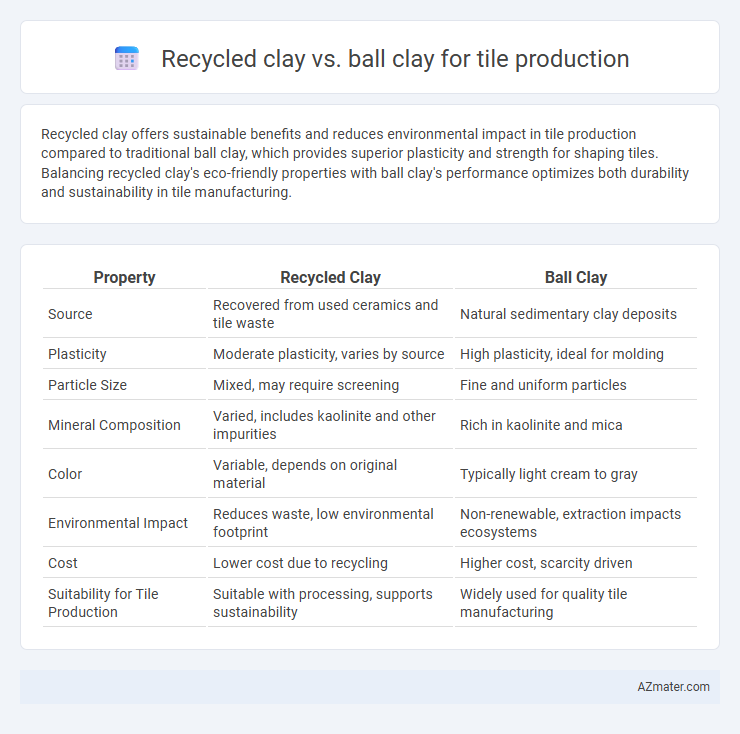Recycled clay offers sustainable benefits and reduces environmental impact in tile production compared to traditional ball clay, which provides superior plasticity and strength for shaping tiles. Balancing recycled clay's eco-friendly properties with ball clay's performance optimizes both durability and sustainability in tile manufacturing.
Table of Comparison
| Property | Recycled Clay | Ball Clay |
|---|---|---|
| Source | Recovered from used ceramics and tile waste | Natural sedimentary clay deposits |
| Plasticity | Moderate plasticity, varies by source | High plasticity, ideal for molding |
| Particle Size | Mixed, may require screening | Fine and uniform particles |
| Mineral Composition | Varied, includes kaolinite and other impurities | Rich in kaolinite and mica |
| Color | Variable, depends on original material | Typically light cream to gray |
| Environmental Impact | Reduces waste, low environmental footprint | Non-renewable, extraction impacts ecosystems |
| Cost | Lower cost due to recycling | Higher cost, scarcity driven |
| Suitability for Tile Production | Suitable with processing, supports sustainability | Widely used for quality tile manufacturing |
Introduction to Clay Types in Tile Production
Recycled clay in tile production offers environmental benefits by repurposing waste materials, while ball clay provides superior plasticity and strength essential for tile molding. Ball clay, composed primarily of kaolinite, mica, and quartz, is prized for its fine particle size and high bonding properties, enhancing the tile's structural integrity. Recycled clay varies in composition, potentially affecting consistency and performance, but supports sustainable manufacturing by reducing raw material extraction.
What is Recycled Clay?
Recycled clay in tile production refers to repurposed clay materials recovered from broken or discarded ceramic products, reducing waste and raw material consumption. It differs from ball clay, which is a naturally occurring fine-grained clay known for its plasticity and strength, essential for shaping and durability in tile manufacturing. Incorporating recycled clay enhances sustainability while maintaining the physical properties required for high-quality ceramic tiles.
What is Ball Clay?
Ball clay is a fine-grained, highly plastic sedimentary clay primarily composed of kaolinite, silica, and mica, essential for enhancing the plasticity and workability of ceramic tiles. It is mined from natural deposits and is prized for its ability to improve the strength and durability of both glazed and unglazed tiles. Recycled clay, while environmentally beneficial, often lacks the consistent particle size and mineral composition of ball clay, making ball clay superior for high-quality tile production.
Physical Properties: Recycled Clay vs Ball Clay
Recycled clay exhibits lower plasticity and reduced shrinkage compared to ball clay, making it less workable but more stable during drying and firing processes in tile production. Ball clay has higher fine particle content and excellent plasticity, which enhances moldability and green strength, crucial for intricate tile shapes. The physical differences influence texture uniformity and firing outcomes, with ball clay favoring smoother surfaces and recycled clay offering improved environmental sustainability.
Chemical Composition Comparison
Recycled clay typically exhibits higher silica content and lower kaolinite compared to ball clay, influencing tile strength and durability. Ball clay, rich in kaolinite and organic matter, enhances plasticity and workability but can introduce impurities affecting firing properties. Chemical composition differences affect vitrification temperature and final tile quality, making selection crucial for specific tile performance.
Workability in Tile Manufacturing
Recycled clay often exhibits varied particle sizes and impurities, impacting its consistency and requiring adjustments in water content to maintain optimal workability in tile manufacturing. Ball clay, renowned for its fine particle size and plasticity, provides superior workability, enabling easier shaping and molding of tiles with fewer cracks during drying and firing. Integrating recycled clay can reduce costs and environmental impact, but achieving uniform workability typically demands blending with ball clay to enhance plasticity and strength in tile production.
Firing Behavior and Shrinkage Rates
Recycled clay exhibits variable firing behavior with typically higher porosity and reduced vitrification compared to ball clay, which results in more uneven shrinkage rates during tile production. Ball clay offers consistent plasticity and fine particle size, promoting uniform shrinkage and strong vitrification at standard firing temperatures between 1100degC and 1250degC. Understanding these differences is crucial for optimizing firing schedules and minimizing defects in ceramic tile manufacturing.
Environmental Impact: Sustainability and Waste Reduction
Recycled clay significantly reduces environmental impact in tile production by minimizing raw material extraction and diverting waste from landfills. Ball clay mining often leads to habitat disruption and higher carbon emissions, whereas using recycled clay promotes sustainability through resource conservation and energy savings. Incorporating recycled clay enhances waste reduction efforts and supports eco-friendly manufacturing practices within the tile industry.
Cost Analysis and Economic Considerations
Recycled clay significantly reduces raw material costs in tile production by utilizing waste materials, lowering expenses linked to extraction and processing compared to ball clay. Ball clay, while offering superior plasticity and workability, incurs higher costs due to mining, refining, and transportation, impacting the overall production budget. Economic considerations favor recycled clay for sustainable, cost-effective manufacturing, particularly in high-volume applications where price sensitivity is critical.
Final Product Quality and Performance
Recycled clay in tile production offers sustainable benefits but may introduce variability in mineral composition, potentially affecting tile strength and uniformity compared to ball clay. Ball clay is prized for its fine particle size and plasticity, delivering enhanced tile durability, smooth surface finish, and consistent mechanical properties. Selecting ball clay typically results in higher-quality tiles with superior flexural strength and reduced shrinkage, critical for performance in demanding applications.

Infographic: Recycled clay vs Ball clay for Tile production
 azmater.com
azmater.com